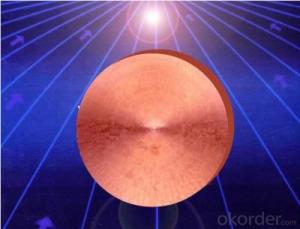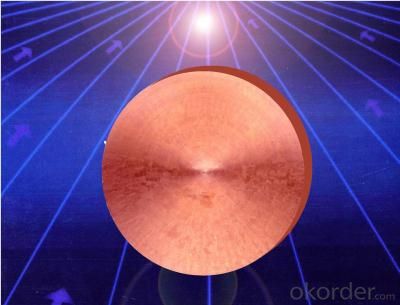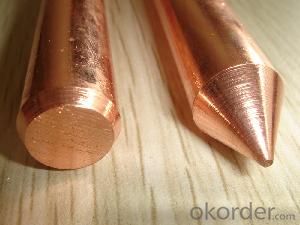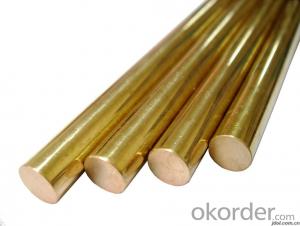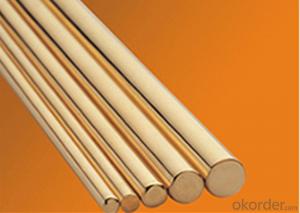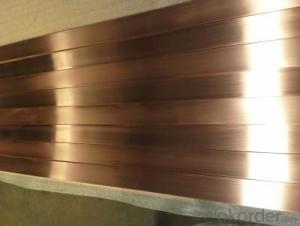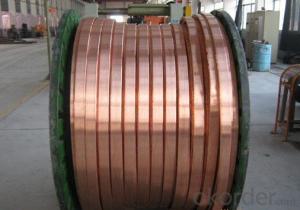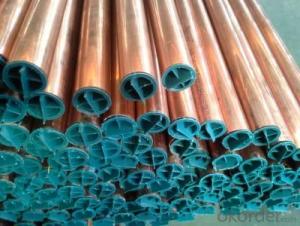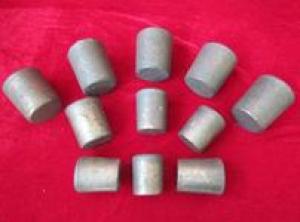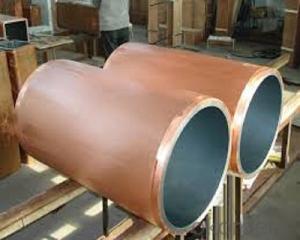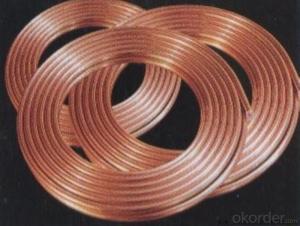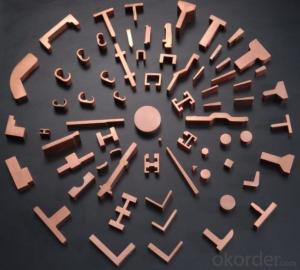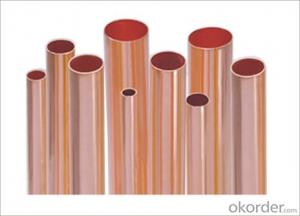High Purity Copper Alloy Bar for Electric Power
- Loading Port:
- Shanghai
- Payment Terms:
- TT OR LC
- Min Order Qty:
- 500 kg
- Supply Capability:
- 10000 kg/month
OKorder Service Pledge
OKorder Financial Service
You Might Also Like
Product: High Purity Copper Alloy Bar
Product: High Purity Copper Alloy Bar
Type: T2, TU1, TU2, TP2
Produced by low-vacuum copper smelting casting technology with its intellectual property right owned by Feichi Copper & Aluminum; high density and high purity product with low hydrogen and oxygen content, usually processed into copper products of various shapes and widely applied in steel making, electric power, ship building, and machinery sectors
High Purity High Density Copper Alloy Bar specification
Type | Cu%(WT) | W%(WT) | RWMA | Density | E-conductivity(Min) | heat conduction | thermal expensivity | |
Class | (Min) | Hardness | ((W/mK)) | |||||
(Min) | ||||||||
CuW55 | 45±2 | Balance | 10 | 12.30g/cm3 | 49%IACS | 125HB | ~260 | ~11.7(10-6/K) |
CuW60 | 40±2 | Balance | 12.75g/cm3 | 47%IACS | 140HB | |||
CuW65 | 35±2 | Balance | 3.30g/cm3 | 44%IACS | 155HB | |||
CuW70 | 30±2 | Balance | 13.80g/cm3 | 42%IACS | 175HB | ~240 | ~9.7(10-6/K) | |
CuW75 | 25±2 | Balance | 11 | 14.50g/cm3 | 38%IACS | 195HB | 200~230 | 9.0~9.5 (10-6/K) |
CuW80 | 20±2 | Balance | 12 | 15.15g/cm3 | 34%IACS | 220HB | 190~210 | 8.0~8.5 (10-6/K) |
CuW85 | 15±2 | Balance | 15.90g/cm3 | 30%IACS | 240HB | 180~200 | 7.0~7.5(10-6/K) |
High Purity High Density Copper Alloy Bar Application:
Produced by low-vacuum copper smelting casting technology with its intellectual property right; high density and high purity product with low hydrogen and oxygen content, usually processed into copper products of various shapes and widely applied in steelmaking, electric power, shipbuilding, and machinery sectors
- Q: Will the price of copper ever go up like silver and gold ?
- Total world production is about 15 million tons per year. Copper demand is increasing by more than 575,000 tons annually and accelerating. Based on 2006 figures for per capita consumption, Tom Graedel and colleagues at Yale University calculate that by 2100 global demand for copper will outstrip the amount extractable from the ground. China accounts for more than 22% of world copper demand. However copper is often recycled so the supply of copper from scrap would increase as the price increases. Secondly, as the price rises, the industrial world has an incentive to substitute other metals for copper. For example the humble US cent - once made 95% from copper is now.. Copper-plated zinc, 1982 to date. In mid-1982, the coin's composition was changed again, this time to copper-plated zinc. The last mostly-copper cents (95% copper metal composition) were produced by the Denver Mint on October 22, 1982. The copper-plated coins are still being produced today. They are composed of an inner core alloy of 99.2% zinc and 0.8% copper with an outer plating of pure copper, for an overall composition of 97.5% zinc and 2.5% copper... (wikipedia) So you can't say never but the possibility is very remote.
- Q: Its a minor leak in a hot water side on a hall way shower. I‘m trying to avoid having to cut the wall on the back side in order to solder a new fitting or re-soldering. I figure I can ask those professional plummers out there.
- It shouldn't make much of a difference. the thing that would be affected the most would be the difference in your speedo. I dont think the brakes will be affected.
- Q: Great timing for plumbing trouble! Not a lot of cash right now, I have developed multiple leaks over time on my hot and cold water pipes. I would like to find a good residential plumbing company in the san jose california area, my house is located within the zip code 95112 area (down-town Japan town). I would be glad if someone can refer me a good plumber that can save me money. Thanks my fellow community members.
- I hate to add to your troubles, but you should get hold of an electrician, too, and make sure your house electrical ground is not also connected to your plumbing pipes - that's a significant cause of deteriorating copper pipes like this.
- Q: I know that copper can turn your skin green, I honestly don't care about that because I wouldn't wear it for extended amounts of time. However, my dad claimed that copper could poison your blood, but I think he is just ill-informed.It still worries me, though, is there any sort of hazard for wearing copper plugs in my ears?They aren't real body jewelry, by the way, they are just some pieces of piping from Home Depot. And yes, I know this isn't a safe and great idea, but I can't afford a lot of jewelry so I get a lot from hardware stores.Please don't tell me about how the fact that I bought piping is stupid, just please tell me (based on fact) if it could hurt me or not.
- It really depends on the level of copper in the jewelry. High amounts and wearing it long amounts of time could be damaging, and the source to where you are wearing the jewelry is a factor as well.
- Q: Who can tell me the weight calculation formula of copper tube?
- Copper tube (outer diameter thickness) * thickness *0.02796Brass tube (outer diameter thickness) * thickness *0.0267That's theoretical weight per metre
- Q: This boy at my school drank about 50ml - 100ml of copper sulfate - he had to be flown out by a helicopter & he needed a stomach pump - will he die?
- Copper sulfate can be toxic, but not in that amount, especially in solution like that. That amount isn't deadly, although he probably got quite sick, but it's not a good idea to ingest any lab chemicals.
- Q: I need to write a paragraph on copper, what are some good things to write? Dont just give me the link to wikipedia, that doesnt help me. The first person to like actually answer my question will get 10 pionts, so why not just try?
- Write about some of its' common uses. Obviously in electrical wires, since it is a good conductor of electricity. As a component in the alloy brass (copper and zinc) and in the alloy bronze (copper and tin). It is great (if you can afford it) as gutters and roofs. You often see it on church roofs and some public building such as the Statue of Liberty. It is often used mixed in some metals for rings (jewelery), thus the green finger. It makes a great poison in lakes, ponds, aquariums, and the such, since algae and some other aquatic plants are killed by it. Finally, it looks cool in fireworks (green colors). Get an A.
- Q: Help please!Copper has a cubic close-packed structure. Why does copper wire not break when it is bent? Diamond is used as an abrasive on cutting tools. How do you explain this property in terms of the structure of diamond? List one common property of diamond.Graphite is used as a lubricant. How do you explain this property in terms of the structure of graphite? What is one common property of graphite?Thanks so much! 10 points for the best answer!!
- Ions are purely atoms with lacking electrons, constructive value, or better electrons, unfavorable value. A single atom with the two of those circumstances could be stated as an ion. Get 2 or extra of those ions jointly and additionally you get a polyatomic ion. Poly (many), atomic (atoms) ion (charged atom). Ions are atoms, polyatomic ions are purely distinctive ions bonded jointly.
- Q: ok so i am doing a report on copper and i need some questions that i can talk about and anwser....already i have where it is mostly from, things that are made from it and its history...what else should i talk about??????....i need help!
- You could ask why teh copper penny is no longer copper, but a zinc alloy
- Q: Does the copper penny thing really work for ringworm? How exactly do I do this treatment?
- This works due to copper's antimicrobial properties. Copper has antimicrobial properties include acting as a fungicide. And, ringworm is actually a fungus. A copper solution is made by dissolving copper oxide on the surface of the pennies in to a solution. This is then applyed to the affected area. To made a copper solution, soak some copper pennies (1982 or older may be best) in a bit of vinegar (white or cider, doesn't matter), then apply the liquid to the affected area. If you do this 2 or 3 times a day, then the ringworm should be gone in about 2 weeks.
Send your message to us
High Purity Copper Alloy Bar for Electric Power
- Loading Port:
- Shanghai
- Payment Terms:
- TT OR LC
- Min Order Qty:
- 500 kg
- Supply Capability:
- 10000 kg/month
OKorder Service Pledge
OKorder Financial Service
Similar products
Hot products
Hot Searches
Related keywords
